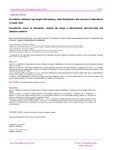Mostrar o rexistro simple do ítem
Correlación entre la dismetría, reparto de carga y alteraciones estructurales del miembro inferior
| dc.contributor.author | Martínez Sánchez, Rosa María | |
| dc.contributor.author | Baño Alcaraz, Aitor | |
| dc.contributor.author | García Vidal, José Antonio | |
| dc.contributor.author | Belando Navarro, Marta | |
| dc.contributor.author | Martínez Carrasco, Ángel | |
| dc.contributor.author | Belmonte Albaladejo, Agustín Ángel | |
| dc.date.accessioned | 2020-11-30T21:17:29Z | |
| dc.date.available | 2020-11-30T21:17:29Z | |
| dc.date.issued | 2020 | |
| dc.identifier.citation | Martínez Sánchez, R. M., Baño Alcaraz, A., García Vidal, J. A., Belando Navarro, M., Martínez Carrasco, Ángel, & Belmonte Albaladejo, A. Ángel. (2020). Correlación entre la dismetría, reparto de carga y alteraciones estructurales del miembro inferior. European Journal of Podiatry / Revista Europea De Podología, 6(1), 19-25. https://doi.org/10.17979/ejpod.2020.6.1.5726 | es_ES |
| dc.identifier.issn | 2445-1835 | |
| dc.identifier.uri | http://hdl.handle.net/2183/26856 | |
| dc.description.abstract | [Resumen] Objetivo: Establecer la relación entre la diferencia de longitud, el reparto de carga en bipedestación y las alteraciones estructurales del miembro inferior. Material y métodos: Se realizó un estudio descriptivo, observacional, transversal con una muestra de 31 pacientes (49.1% hombres/58.1% mujeres). Se obtuvieron variables antropométricas y sociodemográficas, medición de las extremidades inferiores, ángulo Q y del valgo del calcáneo y evaluación del reparto de carga en el miembro inferior. Resultados: Se obtuvo una concordancia casi perfecta (k = 0,9; p = 0,000) entre las mediciones espina ilíaca antero superior- maléolo externo y espina ilíaca antero superior- maléolo interno. Conclusiones: Tras determinar la irrelevancia de tomar unas referencias óseas u otras, se ha obtenido que el miembro inferior izquierdo es más largo en la mayoría de la población siendo mayor el reparto de carga en el retropié de la pierna más corta. | es_ES |
| dc.description.abstract | [Abstract] Objective: to establish the relationship between the difference in length, the distribution of the load in the standing position and the structural alterations of the lower limb. Material and Methods: A descriptive, observational, cross-sectional study was carried out with a sample of 31 patients (49.1% men / 58.1% women). Anthropometric and sociodemographic variables were obtained, measurement of the lower extremities, Q angle and calcaneal valgus and evaluation of the load distribution in the lower limb. Results: An almost perfect concordance (k = 0.9; p = 0.000) was obtained between the measurements of the anterior superior iliac spine-external malleolus and the anterior superior iliac spine-internal malleolus. Conclusions. After determining the irrelevance of taking some bone landmarks or others, it has been obtained that the lower left limb is longer in the majority of the population, with greater load distribution on the hindfoot of the shorter leg. | es_ES |
| dc.language.iso | spa | es_ES |
| dc.publisher | Universidade da Coruña | es_ES |
| dc.relation.uri | https://doi.org/10.17979/ejpod.2020.6.1.5726 | es_ES |
| dc.rights | Atribución-NoComercial-CompartirIgual 4.0 España | es_ES |
| dc.rights.uri | http://creativecommons.org/licenses/by-nc-sa/4.0/es/ | * |
| dc.subject | Dismetría de miembros inferiores | es_ES |
| dc.subject | Calcáneo | es_ES |
| dc.subject | Postura | es_ES |
| dc.subject | Leg length inequality | es_ES |
| dc.subject | Calcaneus | es_ES |
| dc.subject | Posture | es_ES |
| dc.title | Correlación entre la dismetría, reparto de carga y alteraciones estructurales del miembro inferior | es_ES |
| dc.title.alternative | Correlation between Leg Length Discrepancy, Load Distribution and Structural Alterations in Lower Limb | es_ES |
| dc.type | info:eu-repo/semantics/article | es_ES |
| dc.rights.access | info:eu-repo/semantics/openAccess | es_ES |
| UDC.journalTitle | EJPOD: European Journal of Podiatry = Revista europea de podología | es_ES |
| UDC.volume | 6 | es_ES |
| UDC.issue | 1 | es_ES |
| UDC.startPage | 19 | es_ES |
| UDC.endPage | 25 | es_ES |






